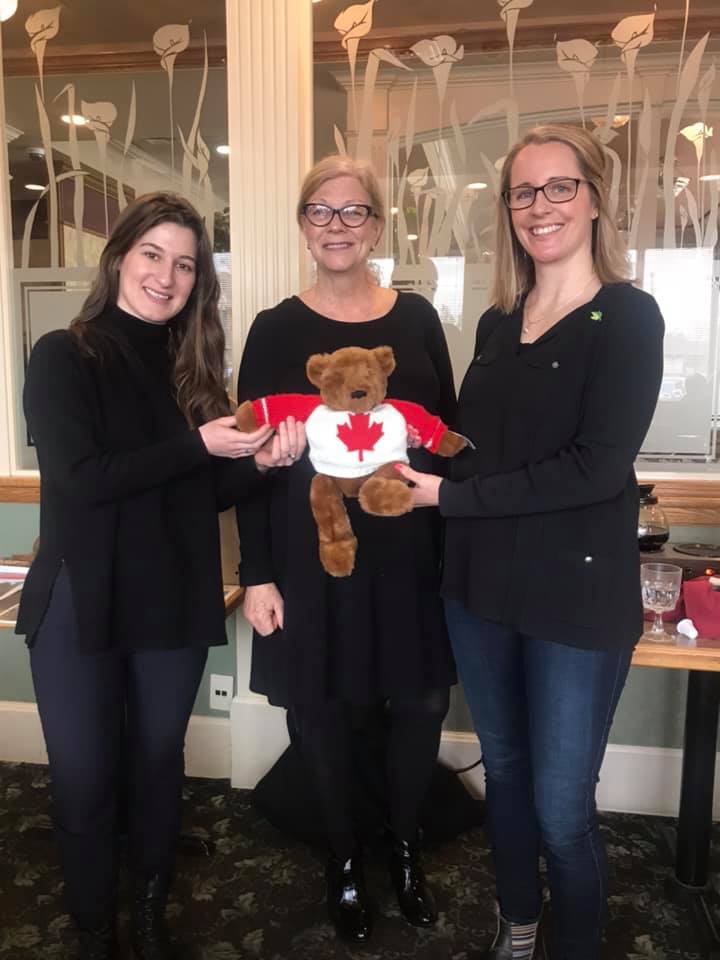Nature Conservancy of Canada (NCC) activities in South Western Ontario
Presenters were:

Kristen Bernard (right above)- She oversees the acquisition of property and Stewarding all properties. The Conservancy uses a combination of Science, Securement of acreage, Stewardship of the acreage and Engagement the public to understand the benefits.
Laura Vaughn (left above) – Fundraiser for the Conservancy. 80% of funds raised go to the conservation of land. (middle above is our own Barbara Warnock, photo compliments of Trudy and our Facebook page)
The Earth's biological diversity is being lost at a rate that impoverishes our quality of life and threatens our future. Wetlands, tallgrass prairies, and coastal marshes comprise a small fraction of the area that we knew as children. 706 species are at risk. We need wetlands to reduce the impact of flooding. Three things that contribute to this problem: A changing climate, habitat loss & fragmentation and an increase of invasive species. At the Canadian level of NCC: 35 million acres (4 times the size of Vancouver Island) have been conserved, $82 Million per year are spent on the conservancy, $130 million worth of endowment properties are managed. NCC partners with other land trusts/conservancies and works with foundations that collect money for the conservancy. Part of the 708 volunteers in Ontario help with NCC.
Not all conservancies operate with the same methods. For instance, conservation authorities support themselves and their infrastructure by selling logging rights. The NCC has purchased land from one Conservation Authority and formed a beneficial partnership that preserved the Carolinian tract slated for logging. The NCC buys and acquires properties so that the lands become contiguous one with the other. That provides access corridors for wildlife so that populations can increase and be more diverse.
The NCC restores habitat for wildlife and creates new wetlands. Tallgrass seed mixes are spread to create a tallgrass prairie habitat. Ponds have been created that attracted endangered turtles within 3 years. Invasive plant species are removed and replaced with a diversity of plants.
See the website http://www.leaveyourlandmark.ca and support the NCC Leave Your Landmark Campaign.
The Carolinian forest is a special ecological territory from Lambton County to St Catharines. Please look at the downloadable slideshow https://clubrunner.blob.core.windows.net/00000001070/en-ca/files/homepage/ncc-slide-show/ON_St-Thomas-Rotary-Club_Presentation_Feb-2020.pdf to see the wonderful vacation spots and hiking trails available in NCC lands of the Carolinian Zone in our own backyard.
Trish won the 50/50 draw.
Adriana (Fine Master) The Feb Rotarian magazine and article “Braking News” reports that our world-wide culture of watching too much news (mostly bad) makes us anxious, hyper-aroused, sleepless and fearful. She suggests that we should dramatically reduce our screen and media time and take the advice of our speakers: visit/walk/volunteer in the conservancy areas close to us to get some peace of mind.
Happy Finns:
Barb 1 – “Book of Joy” with reports from spiritual leaders. Doug Barrett was particularly good at spreading joy.
Bill 2 – 19th birthday of grandson, speakers
Malcolm 2 – speakers and he will be away for 3 weeks England
Mary 1 – Speakers
Ron 3 – Speakers, Joy’s birthday, Valentines day
Trudy 2 – Speakers, spent time with Karen Vecchio regarding women’s advocacy
Pat M 3 – Speakers, 2 birthdays
Connie 1 – Speakers
Adriana 1 -Andrew swam well at school regional competition in his new
Speedo swim suit
Stew 1 – A Speedo did not work for him, the family would not let him wear one
Trish 3 – Speakers, daughter and daughter-in-law February birthdays and won 50/50
Duty Roster
Date | SAA | Greeter | Fine Master |
Feb 19 | Mary Morin | Connie Davidson | Pat Martyn |
Feb 26 | Meeting cancelled | Music Festival | |
Mar 4 | Ron Somerville | Stew Shouldice | Suzanne Ferguson |
Mar 9 | Ron Somerville | Barbara Warnock | Bill Horn |
Mar 16 | Ron Somerville | Trish Shouldice | Trudy Kanellis |